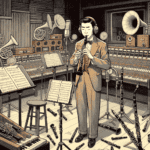The clarinet in film music holds a special place and it's not surprising given its versatility and rich tonal quality. When we think of iconic movie scores, the clarinet, with its ability to evoke a spectrum of emotions, certainly stands out. This article explores the fascinating world of clarinet in film music and uncovers some intriguing recording facts.
A Brief History of Clarinet in Film Music
Many outstanding film scores have featured the clarinet prominently. John Williams' score for Schindler's List uses the clarinet's mournful melody to capture the essence of the film's solemn moments. In contrast, Woody Allen's movies often feature playful and mischievous clarinet tunes, highlighting the instrument's versatility.
Recording Techniques for Clarinet in Film Music
Recording film music with clarinet involves specific techniques to suit the medium. One important aspect is microphone placement. To capture the clarinet's full, resonant sound, a microphone is typically placed about 12-18 inches away, at the level of the bell, angled slightly towards the middle joint. This approach helps capture the full body of the sound without overly emphasizing any particular frequencies.
| Recording Aspect | Details |
|---|---|
| Microphone Distance | 12-18 inches |
| Microphone Position | At the level of the bell |
| Microphone Angle | Slightly towards the middle joint |
The Impact of Recording Environment
The recording environment plays a significant role in capturing the clarinet's sound. Studios designed for film score recordings, like Abbey Road Studios, offer acoustically treated rooms that enhance the natural sound of the clarinet. This contrasts with live concert hall recordings, where ambient noise and reverb can significantly alter the sound.
Microphone Techniques
Experienced recording engineers often use a combination of close and room microphones to achieve a balanced sound. The close mic captures the intricate details, while the room mic picks up the ambiance, adding depth and character to the recording.
The Importance of Clarinet Choice
The choice of clarinet brand can also influence the recording process. Martin Freres clarinets, known for their excellent craftsmanship and tonal clarity, are favored by many professionals. They offer a unique blend of warmth and precision, making them suitable for both orchestral and solo film music recordings.
EQ and Processing in Clarinet Recording
EQ and processing are important elements in clarinet recording. To highlight the clarinet's distinct tone, engineers might gently boost frequencies around 2-3 kHz for presence and clarity, while ensuring there's a balance so as not to overshadow other instruments in the mix.
Notable Film Scores Featuring Clarinet
Several film scores prominently feature the clarinet, showcasing its ability to convey different moods—from melancholy to mystery, and even tension. Some noteworthy examples include:
- Jerry Goldsmith's Chinatown
- Bernard Herrmann's scores for Hitchcock's films
Essential Skills for Aspiring Film Music Clarinetists
For clarinetists aiming to work in film music, certain skills are particularly valuable:
- Strong sight-reading abilities
- Quick adaptability to fast-paced recording sessions
- Versatility with different types of clarinets (e.g., bass clarinet)
Instrument Maintenance for Recording
Keeping your instrument in top condition is crucial for recording. This includes:
- Regular cleaning
- Proper reed selection
- Consistent practice
Conclusion
The clarinet's role in film music is both significant and varied, from evoking intense emotions to providing subtle, textural soundscapes. Understanding the recording processes, environment, and technical aspects helps in appreciating the fine details that contribute to those memorable movie scores.
Whether you're new to the instrument or have years of experience, exploring these aspects can strengthen your connection with the clarinet and potentially lead to exciting opportunities in film music. Remember, the harmony between your instrument and your skill can create something truly special, both in recording studios and beyond.
Table of Contents
- A Brief History of Clarinet in Film Music
- Recording Techniques for Clarinet in Film Music
- The Impact of Recording Environment
- Microphone Techniques
- The Importance of Clarinet Choice
- EQ and Processing in Clarinet Recording
- Notable Film Scores Featuring Clarinet
- Essential Skills for Aspiring Film Music Clarinetists
- Instrument Maintenance for Recording
- Conclusion








